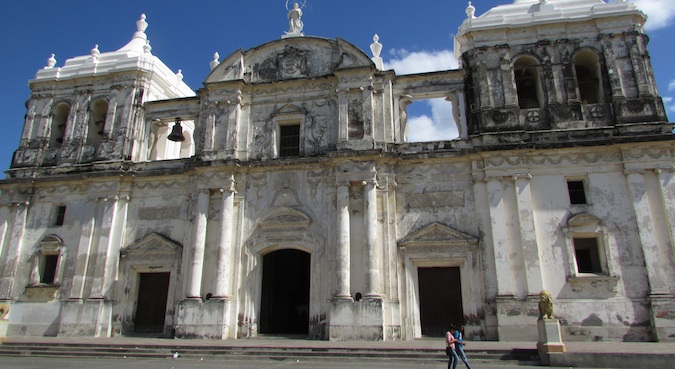Hello ladies and gents this is the viking telling you that today we are talking about a beautiful little country called
Nicaragua, officially the Republic of Nicaragua , is the largest country in the Central American isthmus, bordered by Honduras to the northwest, the Caribbean to the east, Costa Rica to the south, and the Pacific Ocean to the southwest. Managua is the country's capital and largest city and is also the third-largest city in Central America, behind Tegucigalpa and Guatemala City. The multi-ethnic population of six million includes people of indigenous, European, African, and Asian heritage. The main language is Spanish. Indigenous tribes on the Mosquito Coast speak their own languages and English.
Surf in San Juan del Sur

 This extraordinary island is located on Lago de Nicaragua and is formed by two joined volcanoes, Concepción and Maderas. Hiking, kayaking, cycling, and healthy food are the island’s main draws. Hiking the volcanoes is as hard as it appears: you’ll need to start really early or the midday heat will slow you down significantly.
This extraordinary island is located on Lago de Nicaragua and is formed by two joined volcanoes, Concepción and Maderas. Hiking, kayaking, cycling, and healthy food are the island’s main draws. Hiking the volcanoes is as hard as it appears: you’ll need to start really early or the midday heat will slow you down significantly.
 This city was Nicaragua’s capital until 1857. To this day it remains the country’s intellectual capital and is home to the National University. Remnants of the political war between the Somozas and Sandinistas can be seen in the graffiti and murals around the city. There are a lot of churches here, many art museums, and a burgeoning food movement.
This city was Nicaragua’s capital until 1857. To this day it remains the country’s intellectual capital and is home to the National University. Remnants of the political war between the Somozas and Sandinistas can be seen in the graffiti and murals around the city. There are a lot of churches here, many art museums, and a burgeoning food movement.
NICARAGUA
Nicaragua, officially the Republic of Nicaragua , is the largest country in the Central American isthmus, bordered by Honduras to the northwest, the Caribbean to the east, Costa Rica to the south, and the Pacific Ocean to the southwest. Managua is the country's capital and largest city and is also the third-largest city in Central America, behind Tegucigalpa and Guatemala City. The multi-ethnic population of six million includes people of indigenous, European, African, and Asian heritage. The main language is Spanish. Indigenous tribes on the Mosquito Coast speak their own languages and English.
Surf in San Juan del Sur

A hit with surfers and backpackers, San Juan del Sur is the most popular beach destination in Nicaragua. All the beaches are beautiful and lapped by warm water. Here you’ll find great surfing (expect to pay around $9 USD per day for board rental and $25 per hour for lessons), the second-largest statue of Jesus in the world (behind Christ the Redeemer in Brazil), and lots of cheap bars.
The best way to travel to San Juan del Sur from the airport is by booking an airport shuttle. The cost is $40 per person or $65 for two people each way and takes around 2 hours.
Visit Ometepe Island
 This extraordinary island is located on Lago de Nicaragua and is formed by two joined volcanoes, Concepción and Maderas. Hiking, kayaking, cycling, and healthy food are the island’s main draws. Hiking the volcanoes is as hard as it appears: you’ll need to start really early or the midday heat will slow you down significantly.
This extraordinary island is located on Lago de Nicaragua and is formed by two joined volcanoes, Concepción and Maderas. Hiking, kayaking, cycling, and healthy food are the island’s main draws. Hiking the volcanoes is as hard as it appears: you’ll need to start really early or the midday heat will slow you down significantly.
The volcano hikes cost around $20 USD if you’re part of a group or up to $40 if you’re by yourself (hike with a guide, as it’s rather unsafe due to poorly maintained trails). Keep an eye out for all the monkeys — spotting them was more interesting than the hike!
Visit “new” León
 This city was Nicaragua’s capital until 1857. To this day it remains the country’s intellectual capital and is home to the National University. Remnants of the political war between the Somozas and Sandinistas can be seen in the graffiti and murals around the city. There are a lot of churches here, many art museums, and a burgeoning food movement.
This city was Nicaragua’s capital until 1857. To this day it remains the country’s intellectual capital and is home to the National University. Remnants of the political war between the Somozas and Sandinistas can be seen in the graffiti and murals around the city. There are a lot of churches here, many art museums, and a burgeoning food movement.
Make sure you visit the Museum of the Revolution, a fascinating museum about the Sandinista movement. The $2 entrance fee includes a guide. León is also where people base themselves for trips to the nearby volcanoes.
What do you think? i dont know about you but i will be going soon i hope anyway have a chilled day from the Viking.
Comments
Post a Comment